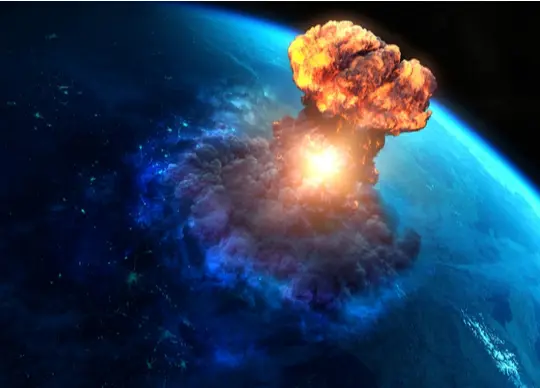
By Chris Flaherty.
1 February 2022
INTRODUCTION
This short essay explores a rogue state strategy where it can develop and launch a relatively simple two (three) stage rocket that can carry a Nuclear Space Mine, and place this in orbit around the Earth. Relying on the Earth’s rotation over a 24-hour period (the full planetary rotation), a series of rockets could be launched into various positions within the Earth’s Satellite Layer delivering several Nuclear Mines for immediate or later detonation. Detonating at various orbital layers a sequence of Nuclear Blasts, and Electromagnetic Pulse: EMP effect, and residual radiation field would destroy a portion of the World’s satellite capability. The function of this strategy would be to dissuade a more powerful adversary, or the international community from attempts to contain or overthrow the rogue state, and continue to accept its dominance in global affairs. The ‘strategy’ being pursued has three core elements:

For a rogue state that has little or no stake in Space, and faced by a vastly technologically superior state, it can pursue a ‘Low-Tech’ Space Warfare option. A state that has grown reliant on their Space-Based Infrastructure embedded in the Earth’s Satellite Layer, presents a highly attractive target; that within one rotation of the planet, could be massively damaged with long-term historical consequences for a Space-Based Society to function or direct their military forces.
NUCLEAR SPACE MINE THREAT
A Planetary Rotational Nuclear-EMP Campaign on the Earth’s Satellite Layer has its origin in earlier Soviet Space Warfighting concept development. One of the functions of the 1987 Polyus Spacecraft is believed to have been its use as a bus for a load of Nuclear Space Mines. Some have argued, the launcher component was, “capable of delivering Nuclear warheads from orbit to any point in the … [United States] … in six minutes.” (Grondine, 2019) Which implies that each Nuclear Mine-Warhead was encased in a re-entry vehicle. However, rather than used as an orbital bombarder, it is also known during the Cold War, the Soviets had Nuclear Space Mines on the drawing board as a possible Anti-Satellite Weapon (Hendrickx, 2016; Martin, 2021). Called Kamin: Fireplace Space Mines, this was a 1985 concept for a constellation of small interceptors deployed in orbits close to potential target satellites (Hendrickx, 2016). Several were intended to be bused into orbit by a launch vehicle. Orbiting craft like the Kamin-N (Low Earth Orbit variety) Space Mines could have circled the Earth very-close to their targets.
Current North Korean Space Warfare ability, has been suggested, extends to building, and launching into orbit Nuclear Space Mines (Harrison, 2018, 2021; Pry, 2021). If such an ability exists it is newly acquired. North Korea has only twice placed a satellite in Earth orbit, the first was in December 2012; following three previous failed attempts: July 2006, April 2009, and April 2012. Since then, a second satellite went into Earth orbit – the Kwangmyongsong-4 [KMS-4] an Earth observation satellite, in February 2016.
The Anti-Satellite Weapon can be sent against a target satellite from the Earth’s Surface, as a direct-ascent version; or it can work as a co-orbital one. It requires various onboard sensors: optical, infrared, radar, and a guidance system steering the Spacecraft containing the weapon to its designated target satellite. It is widely viewed currently, that North Korea have not tested or attempted development of these types of Space Warfare weapons (Harrison, 2018). An orbiting Nuclear Space Mine is a ‘Low-Tech’ Space Warfare option. Intended as an unguided warhead detonating in the vicinity of a target satellite. It does not directly strike its intended target. It can create a debris field from whatever survives being vaporised in the initial blast. It creates an Electromagnetic Pulse: EMP effect, and residual radiation field complicating future operations for a target and other satellites in a similar orbit. The orbiting Nuclear Space Mine has another degree of simplicity: “[it]… does not require re-entry vehicle technology like a Nuclear-armed Intercontinental Ballistic Missile would.” (Harrison, 2018)
States like North Korea could launch a crude direct-ascent attack, using a two (three) stage rocket capable of lifting into Earth orbit a Spacecraft carrying a nuclear warhead. Some are quite small. For instance, the United States W80 contained within a Cruise Missile is about the size of a conventional 250 pound: 110-kilogram bomb, and is 11.8 inches: 30 centimetres in diameter, and 31.4 inches: 80 centimetres long. While the first-generation North Korean Nuclear missile warhead is estimated to weigh around 1,300 pounds: 589.6 kilograms. Which puts the lift vehicle into the lower end of the small satellite launch capability range. Currently, North Korea’s Ballistic Missile and Nuclear capabilities allow it, “[to]… theoretically launch a Nuclear weapon into Space and detonate it.” (Harrison, 2018) It is further noted in a 2018 study that there was:
- “Some evidence that North Korea may be developing or has already acquired non-kinetic physical counterspace weapons such as a Nuclear EMP device.” (Harrison, 2018)
In 2017, the Commission to Assess the Threat to the United States from Electromagnetic Pulse Attack, noted how back in 2004: “Russian generals warned … the design for a Russian EMP warhead was unintentionally transferred to North Korea.” (Harrison, 2018) In 2009, South Korean intelligence officials told the press that Russian scientists were in North Korea helping to develop an EMP weapon (Harrison, 2018). While in 2013, a Chinese military commentator indicated that North Korea already had Super-EMP nuclear weapons (Harrison, 2018). In 2021, a United States based assessment added this possible Space Warfare scenario:
- “Any of North Korea’s … [Intercontinental Ballistic Missiles] … or their Space Launch Vehicle could probably deliver a Super-EMP warhead to the United States. North Korea orbited a satellite weighing about 100 kilograms. One design of a Super-EMP warhead would be a modified neutron bomb, more accurately an Enhanced Radiation Warhead (ERW) because it produces not only lots of neutrons but all kinds of radiation, including lots of gamma rays. Gamma rays cause the … [High-Altitude Electromagnetic Pulse] … effect. One U.S. ERW warhead (the W-82) deployed in NATO during the Cold War weighed less than 50 kilograms. Since an EMP attack entails detonating the warhead at high-altitude, above the atmosphere, the warhead does not even need a re-entry vehicle.” (Pry, 2021)
THREAT MITIGATION AND COUNTER-STRATEGIES
The French Space Defence Strategy identifies using a weapon like a Space Mine, as one of several future potential threats from Earth: Electromagnetic aggression, Cyber-attack, high-altitude nuclear explosion, which need a response (Space Working Group, 2019). The presence of Space Mines close to Global Positioning System satellites, and the possibility of a Space Mine attack is still identified as a plausible Space Security scenario (Harrison, 2021).
A Nuclear Space Mine is encased in a small vehicle and can be camouflaged as a satellite. It can orbit for decades in the proximity of a field of target satellites. It destroys with the initial blast, followed by the Electromagnetic Pulse: EMP effect, and the longer-lasting residual radiation field created. This is because:
- “Nuclear detonations in Space increase the radiation exposure of other satellites and can significantly shorten their lifespan.” (Harrison, 2021)
As a counter to the possibility of a Nuclear Space Mine detonation, the French Syracuse 4A Satellite is stated to be protected against an Electromagnetic Pulse resulting from a nuclear explosion (Agence France-Presse, 2021; 2021). This is achieved through, “Electromagnetic Shielding … [that]… hardens satellites against High-Powered Microwave and Electromagnetic Pulse weapons.” (Harrison, 2021) Hardening a satellite to withstand an Electromagnetic Pulse from a near-by nuclear blast (such as a Nuclear Space Mine detonation), even though this disables/destroys other local satellites, is a type of Deterrence Space Strategy designed to neutralize the weapon’s potency – by ensuring a satellite was able to survive the attack. Perhaps then used to launch a retaliation against the attacker.
North Korea is not a signatory to the 1963 Partial Test Ban Treaty. Putting a nuclear weapon in Space is normally associated with a launch from the Earth’s Surface of a specially adapted rocket booster, to then launch a second or third stage with a nuclear warhead into Earth Circumnavigation Orbit, where it can then move into position to detonate. The same can be achieve by a rocket released from an aircraft. The notion, however, of a pre-placed Space Mine, which has had its true nature concealed when it was launched remains the greatest threat and strategic shock. A race could emerge, where new War Satellites, and next-generation military-use, and civil communications and other key infrastructure satellites – like the Global Positioning System satellites, which can withstand an Electromagnetic Pulse are raced into replacement orbits replacing older fragile versions. To outpace the potential threat by a rogue state to attack the Earth’s Satellite Layer with a nuclear weapon to destroy it, rendering a devastating blow to the Space-Based Societies.
AUTHOR
Chris Flaherty is a Space & Defense Tech and Security News Regular Contributor.
REFERENCES
- Agence France-Presse. 2021 France Launches State-of-Art Military Communications Satellite. Economic Times (24 October).
- Agence France-Presse: News Wires. 2021 France Successfully Launches Cutting-Edge Military Communications Satellite. France24.com (23-24 October).
- Grondine, E. Polyus 2019 Astronautix.com
- Harrison, T. Johnson, K. Young, M. 2021 Defense Against the Dark Arts in Space: Protecting Space Systems from Counterspace Weapons. A Report of the CSIS Aerospace Security Project. Rowman & Littlefield (February).
- Harrison, T. Johnson, K. Roberts, T.G. 2018 Space Threat Assessment 2018. A Report of the CSIS Aerospace Security Project. Center for Strategic and International Studies (April).
- Hendrickx, B. 2016 Naryad-V and the Soviet Anti-Satellite Fleet. Space Chronicle. Volume 69.
- Pry, P.V. 2021 North Korea: EMP Threat (North Korea’s Capabilities for Electromagnetic Pulse (EMP) Attack). EMP Task Force on National and Homeland Security (June).
- Space Working Group (Report of the). 2019 Space Defence Strategy. The French Ministry For The Armed Forces (November).





